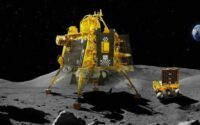India’s Ambitious Leap: Chandrayaan-2 Explores New Frontiers on the Moon
Introduction
In July 2019, India’s space agency, the Indian Space Research Organisation (ISRO), once again captured the world’s attention with the successful launch of Chandrayaan-2, the country’s second lunar exploration mission. Building upon the success of its predecessor, Chandrayaan-1, this mission represented a giant leap for India’s space program, as it aimed to further unravel the mysteries of Earth’s celestial neighbor, the moon. This article delves into the details of Chandrayaan-2, its objectives, accomplishments, and the significance it holds for India’s burgeoning space endeavors.
The Genesis of Chandrayaan-2
The Chandrayaan-2 project was conceptualized and initiated by ISRO in 2007, soon after the triumph of Chandrayaan-1. The objective was to advance the lunar exploration program by deploying an orbiter, lander, and rover on the moon’s surface simultaneously. This holistic approach would significantly enhance India’s capability to study the moon’s topography, mineral composition, and exosphere, while also facilitating the development of lunar technology.
Objectives of Chandrayaan-2
- Orbiter’s Observations: The Chandrayaan-2 orbiter, equipped with advanced instruments, aimed to provide comprehensive data about the moon’s surface, minerals, and exosphere. It would study the moon from orbit for a duration of one year.
- Lander’s Descent: The lander, named Vikram, had the ambitious task of making a soft landing near the moon’s south pole, a region of great scientific interest due to its unique geological features.
- Rover’s Exploration: The Pragyan rover, carried by the lander, was designed to explore the lunar surface, collect samples, and perform on-site chemical analysis.
Chandrayaan-2’s Technology and Instruments
The Chandrayaan-2 orbiter was equipped with eight scientific instruments, including spectrometers, imagers, and radar systems, designed to capture high-resolution images and study the moon’s composition. The Vikram lander and Pragyan rover carried payloads that would enable the study of lunar soil and geology up close.
Chandrayaan-2’s Journey and Challenges
The launch of Chandrayaan-2 took place from the Satish Dhawan Space Centre in Sriharikota, India, utilizing the GSLV Mk III-M1 rocket. The spacecraft embarked on a 3.84 lakh-kilometer journey to reach the moon’s orbit.
Despite its complex mission profile and significant technical challenges, Chandrayaan-2 faced a setback during its landing phase when the Vikram lander lost communication with mission control, ultimately crash-landing on the moon’s surface. While this was undoubtedly a setback, the orbiter continued to function exceptionally well and has since made several significant discoveries.
Legacy and Implications
Chandrayaan-2 represents a bold step forward in India’s space exploration program, showcasing the country’s determination to reach new frontiers in lunar science and technology. Despite the challenges faced during the lander’s descent, the mission’s orbiter has continued to provide invaluable data, contributing to our understanding of the moon’s geological history and the potential presence of water ice.
This mission has also opened doors for future lunar exploration endeavors, with ISRO’s eyes set on the development of Chandrayaan-3, which aims to achieve a successful lunar landing.
Conclusion
Chandrayaan-2, India’s second lunar mission, demonstrated the country’s unwavering commitment to exploring the moon and expanding its footprint in space exploration. While the mission faced setbacks with the loss of the lander, the achievements of the orbiter have furthered our understanding of the moon’s geology and composition. Chandrayaan-2 serves as a testament to India’s growing expertise in space technology and its determination to contribute to the global quest for knowledge beyond our planet. As India continues to push the boundaries of space exploration, Chandrayaan-2 remains a significant milestone on its journey to the stars.


